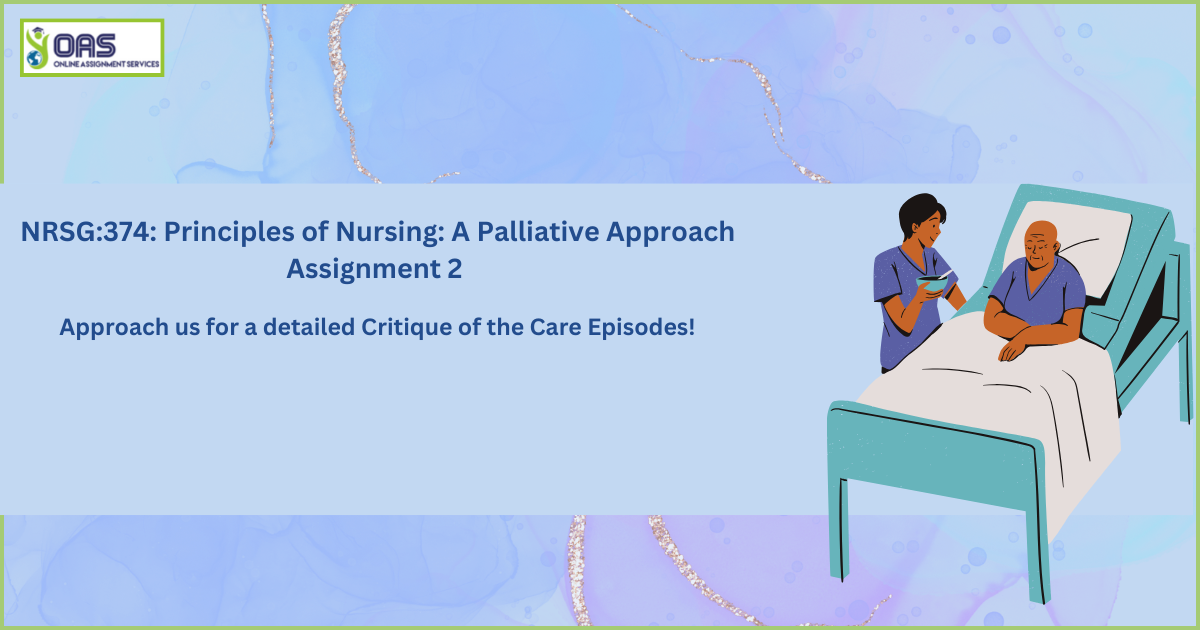NRSG374: Written Critique Assignment Help

NRSG:374: Principles of Nursing: The Written Critique Assignment requires the students to evaluate and analyse the care provided in the given case study and relate it with the theory and guidelines of palliative care. The case study of this assessment was based on Tyler Morten, a 40-year-old man diagnosed with an Amyotrophic lateral sclerosis condition from the past 18 months. Over the last 6 months, Tylers’ condition has deteriorated and the care provided to Tyler is highlighted in the case study. However, it is required that the care should follow the guidelines of Clinical Practice.
The solution of this assessment consists of three main sections: The Introduction, the Critique of the care provided and the Conclusion. The Introduction section is a short description of the Case study of Tyler Morton and guides the reader to write a critique of the episodes of palliative care provided to Tyler and his family in the case study. The following sample introduction showcases our expertise in writing a clear introduction section.
Introduction
The case study is based on Tyler Morton, a 40-year-old man who after multiple symptoms and tests was diagnosed with the health condition of Amyotrophic lateral sclerosis, 18 months ago. 6 months ago, it has also been identified that Tyler’s condition has deteriorated (ACU, 2021). The care provided to Tyler has also been highlighted in the case study, but it is important that the care should be suitable according to the Clinical Practice Guideline (CPG).
The Care of the Dying Patient CPG is a professional guideline for clinical staff and medical professionals which aims to provide guidance to the professionals caring for patients during their end of days (ACU Practice guideline, 2018). This written critique will review the case study which depicts the healthcare provided to Tyler and his family in a palliative care setting.
In the following sample of the critique section, we have demonstrated a clear critique of two separate episodes of care. This will serve as a guideline for students attempting to critique care episodes presented in the case study.
Critique Of The Care Provided
Episode 1:
According to the CPG Care of the Dying Patient, a Symptom Observation Chart or SOC needs to be developed to record patient symptoms and a complete set of observations should be recorded at least every 4 hours and the symptoms must be rated as absent, moderate, mild and severe. Not only that but the guideline also suggests that the SOC document should be shared and discussed with the patient and those who are the closest to the patient (ACU Practice Guideline, 2018). Going by the case study, between the time period of 26th March and 28th March, Friday to Sunday, Tyler was visited by the palliative care team only three times a day, and also, there was no proper documentation of Tyler’s symptoms and neither was the symptoms discussed or shared with Tyler’s family, mainly Catherine, Tyler’s wife (ACU, 2021). Documentation is one of the most crucial responsibilities of nursing as the records offer a trace of the care process which has occurred and is helpful in guiding the process of continued management for the patients (Mutshatshi et al., 2018). Documentation is also a vital aspect of ensuring effective, safe and ethical nursing practice as it acts as a guideline that assists nurses in meeting the standards of practice (Brown et al. 2017). Lack of nursing documentation or errors in reporting patient symptoms can negatively impact efficient care delivery and compromise the safety of the patients (Tajabadi et al., 2020). One aspect which is absolutely clear from the literature is that documentation is an integral component of nursing care and since palliative care is a critical and difficult phase, it should not have been missed by the nurses in the case study as this could seriously affect the quality of life and the care provided to Tyler. It can be established that the nurses did not provide care according to the expectations since the Nursing and Midwifery Board of Australia (NMBA) standard 1.6 also illustrates that the RN maintains comprehensive, timely and accurate documentation of all the assessments, actions, planning and decision-making (NMBA, 2016). Thus, it can be confirmed that the care provided to Tyler in Episode 1 was not in agreement with the CPG or the standard of care.

Episode 2:
The CPG Care of the Dying Patient represents that while reviewing the therapies and interventions for a patient, it is the responsibility of the clinical staff to assess the non-essential interventions and discontinue them based on the patient’s situation (ACU Practice Guideline, 2018). The care provided to Tyler in this regard is optimum and consistent with the guidelines on the afternoon of the 28th March Sunday, the palliative care nurse came to visit Tyler, and looking at his condition of being in pain, agitated and restless and wanting everything to be over, the nurse chose to discontinue the peg feeds (ACU, 2021). The care provided is positive in the sense that uncomfortable interventions such as invasive feeding tubes or CPR can be painful and distressing for the patients during their palliative treatment (Cardona-Morrell et al., 2016). Although, Tham et al. (2021) conclude that it is not acceptable to withdraw a medical treatment or intervention from the patient who might benefit from it, however, Zhong et al. (2022) argue that if an intervention or treatment is no longer helpful in achieving the goals of care for the patient or producing the desired quality of care and is creating pressure or burden on the patient, it is advisable to withhold or withdraw the intervention. As a consequence, the palliative care nurse in the case study did not do anything wrong by discontinuing peg feed since it might have contributed towards additional restlessness and pain in Tyler (Borbasi et al., 2019). The care provided also meets the expectations of the NMBA standard 6.1 which portrays that the RN provides quality and safe practice to the patient in order to attain the agreed outcomes which are also responsive to the care needs of the patients (NMBA, 2016). The care provided is also applicable with respect to the National Safety and Quality Health Service Standards (NSQHSS) standards 5.14c and 5.14d. The standard draws that, the workforce in partnership with the patients to review and accordingly update the care plan if the care is not effective, and that the patient’s needs should be reassessed as per the changes in physical or mental condition and behavior of the patient (Australian Commission on Safety and Quality in Health Care, 2020). Thus, the care provided in Episode 2 is effective.
Need the remaining two care episodes as well? Call Us at +61871501720.

